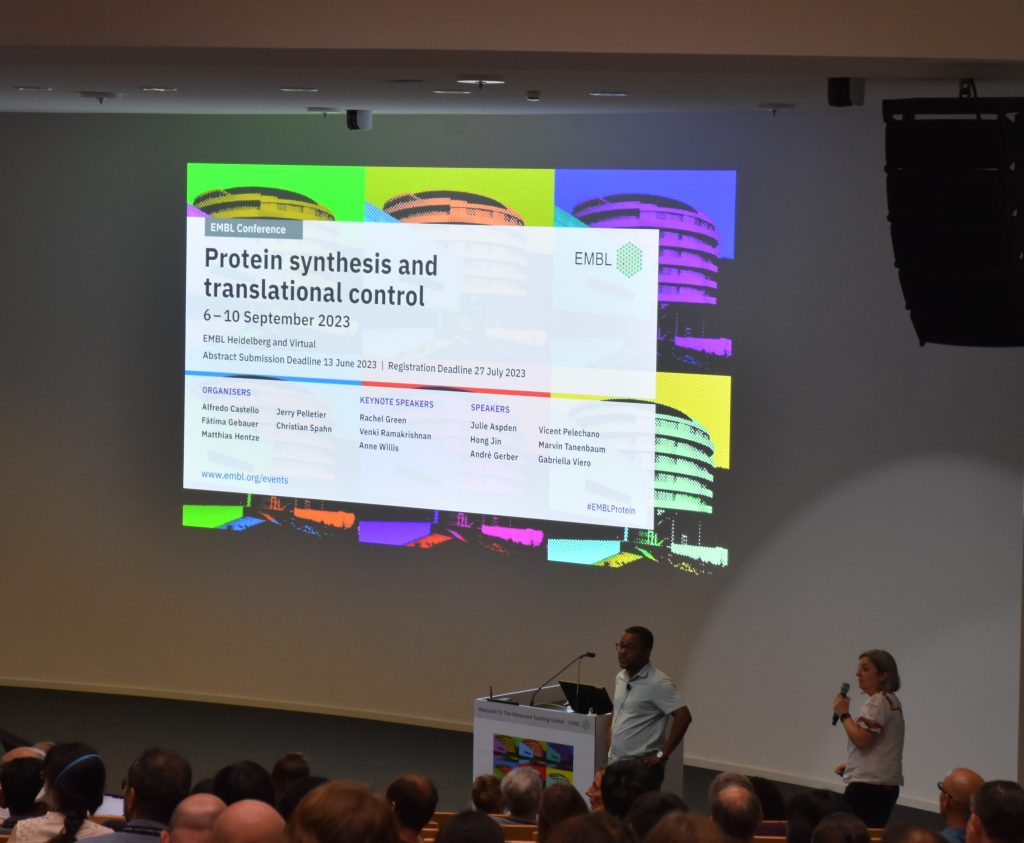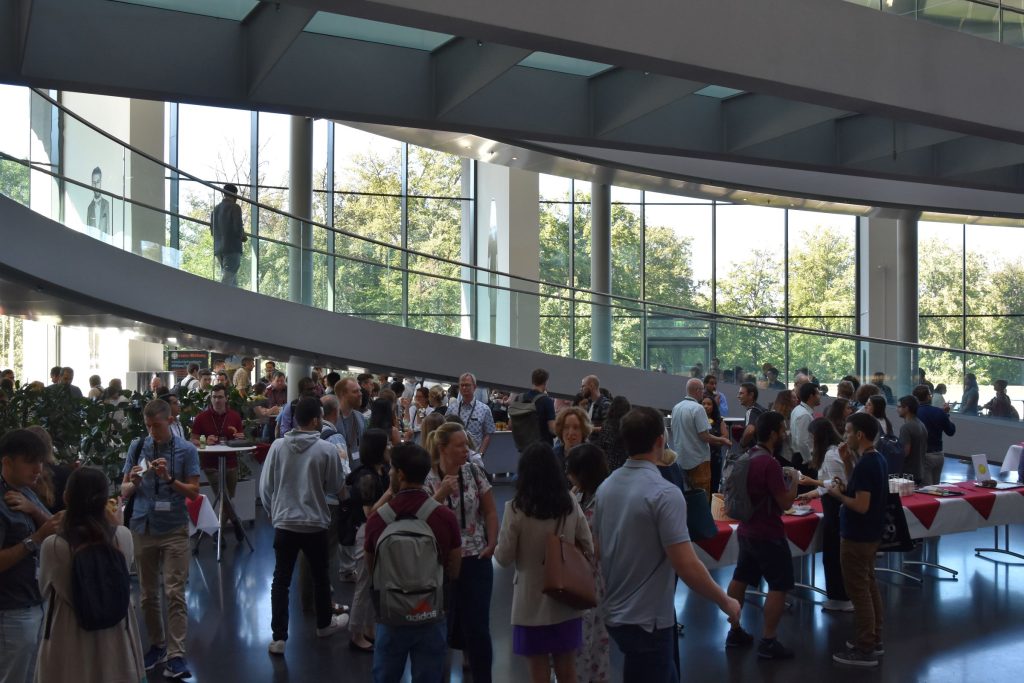Impressive presentations and posters at the EMBL Conference ‘Protein synthesis and translational control’
Written by event reporter Parisa Naeli (@PariN39103649)
The Protein Synthesis and Translational Control Conference took place from 6 – 10 September in Heidelberg, Germany and was a unique gathering of researchers in the field of mRNA translation, a mechanism central to shaping cellular proteomics. This hybrid event brought together more than 400 attendees, with an additional 150 participants joining virtually. A total of 268 posters were displayed, fostering an enriching atmosphere for exploring diverse research areas and cultivating new collaborations.
The conference focused on various aspects of protein synthesis, ranging from the molecular and structural understanding of translational machinery to its regulation across different organisms, spanning from bacteria to humans. It commenced with a workshop titled ‘Ribosomes as decision hubs controlling human embryonic cell fate trajectories’ by Immagina BioTechnology, where they explained their tRNA-sequencing workflow and data analysis pipeline. This session was followed by an engaging presentation by Prof. Leo Kurian from the University of Cologne, Germany,(https://www.cecad.unikoeln.de/research/associated-members/dr-leo-kurian) who delved into the role of ribosomes in embryonic development and their regulation by RNA-binding proteins.
Following the opening remarks by the organizers, a touching tribute was paid by Christopher S. Fraser to Prof. John Hershey, a luminary in the field of mRNA translation who had recently passed away.
On day one, the conference featured three exceptional keynote speakers:
Professor Anne Willis , Director of the MRC Toxicology Unit, (https://www.mrc-tox.cam.ac.uk/staff/anne-willis-obe) shared ground-breaking findings related to cell stress, DNA damage, the impact of damage on translation, frameshifting, and cellular responses to different stressors. Professor Rachel Green (https://greenlabjhmi.org/) , from Johns Hopkins School of Medicine, USA, an expert in Ribosome Quality Control (RQC), presented fascinating studies elucidating how collided ribosomes can function as signals to activate cellular stress responses and Venki Ramakrishnan, from the MRC Laboratory of Molecular Biology, UK (https://www2.mrc-lmb.cam.ac.uk/group-leaders/n-to-s/venki-ramakrishnan/), renowned for his work on the structure of ribosomes, shared new insights into the structure of translation initiation and interactions between different subunits of the initiation complex.
They keynote presentations can be viewed on the EMBL YouTube Channel: https://www.youtube.com/results?search_query=embl+keynote

This conference comprised six talk sessions, each initiated by a session chair. These sessions covered a wide spectrum of topics within the field of mRNA translation, with speakers presenting cutting-edge research and sharing valuable discoveries. After each talk, attendees engaged in thought-provoking Q&A sessions. As the event was hybrid, online participants also contributed to these discussions.
On day two, the sessions commenced with the ‘Initiation’, mirroring the start of translation in cells. Julie Aspden from the University of Leeds, UK, chaired this session and delivered a captivating presentation on the tissue-specific patterns and functions of 80S ribosomes within cells. Subsequently, ten short talks addressed various aspects of translation initiation and its regulation by different initiation factors.
The scientific discussions continued with session two, the ‘Ribosome/Elongation’, chaired by Hong Jin from the University of Illinois at Urbana-Champaign, USA. Here, ten intriguing talks explored different facets of translation elongation and its impact on mRNA decay, protein folding, and the assembly of protein complexes.
Recognizing the significance of improvement in latest technologies to study translation processes, a dedicated session on techniques development was convened. Chaired by Vicent Pelechano from SciLifeLab, Karolinska Institute, Sweden, this session featured a mix of short talks showcasing newly developed techniques, from in vivo single-cell ribosome profiling to comparative CRISPRi screens.
The fourth session, chaired by Marvin Tanenbaum from the Hubrecht Institute, The Netherlands, delved into interconnections between mRNA translation and turnover. Speakers challenged established dogmas, discussed coupled transcription-translation in bacteria, real-time tracking of coupled transcription-translation, protein nuclear importation, and how translation rate can influence protein localization.
The final day of the conference featured two sessions covering implication of mRNA translation regulation in metabolism, diseases, viral infections, ribonucleoproteins, and Ribosome Quality Control (RQC).
Session five, chaired by Gabriella Viero from the Institute of Biophysics, National Research Council (CNR), Italy, commenced with a thought-provoking talk on the disruption of a multifunctional translation platform in Spinal Muscular Atrophy.
The last session, chaired by André Gerber from the University of Surrey, UK, explored the regulation of translation by factors such as RNA-binding proteins, Phosphofructokinase, and FMRP. Speakers discussed how ribosome collision can activate inflammation and programmed cell death, as well as mechanisms for clearing collided ribosomes.
The conference also allocated dedicated time for ‘Meet the Speakers,’ facilitating valuable interactions with presenters and deeper insights into their research and findings. The emphasis on specific techniques used in the presented data was a notable aspect of these discussions. In addition to the talk sessions, there were three interactive poster sessions.
The quality of the posters and the research shared at the conference was truly impressive.
This brief report provides only a glimpse of the remarkable work presented during the conference.

Attendees actively shared their experiences on social media using #EMBLProtein, and for more highlights from the event, you can explore posts on social media platforms, including X (formerly known as Twitter), using #EMBLProtein.”